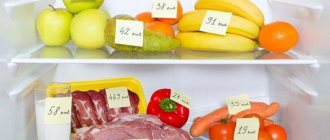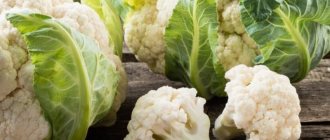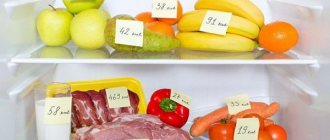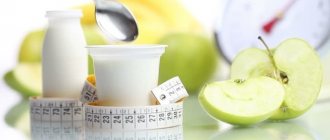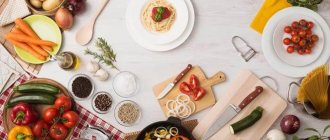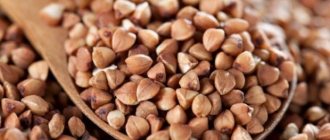What is a food diary and why is it needed?
A food diary can be kept in a notebook, on a computer, an e-book, or from the Internet. This is a kind of detailed drawing up of a proper nutrition plan, where you need to enter information about what was eaten and when, how you feel before and after eating. The whole point is that by keeping such records it will be easier for a person to understand the cause of excess weight and easily solve it. After all, obesity is not always caused by eating large quantities of food; the cause may also be illness or poor lifestyle. Records must be completed regularly. A nutritional schedule for effective weight loss is considered one of the fundamental factors for achieving the desired result.
Diary diary name is necessary
Breakfast calories
Breakfast is the most important meal of the day, as it provides the body with energy for the whole day. The calorie content of an adult's breakfast, subject to proper nutrition, ranges from 300 to 600 kcal, no more and no less.
Examples of menus with breakfast calories not exceeding 500 kcal, very tasty dishes, are:
- Two whole wheat waffles with maple syrup and blueberries;
- One serving of spinach and bacon omelet with two pieces of toasted whole grain toast;
- One serving of granola and pumpkin parfait;
- Bagel, tartlets or bagel made from whole grain flour with homemade processed cheese, herbs and tomatoes;
- Two banana peanut butter pancakes;
- One serving of homemade yogurt with pieces of berries or fruits;
- Salad of fresh vegetables with herbs, sprinkled with olive oil and lemon juice;
- Freshly squeezed vegetable and fruit juices.
By one serving we mean the volume of a prepared dish of 200-250 g, only then the calorie content of breakfast will not exceed the specified norm. Such breakfasts not only satisfy hunger well, but also provide the body with fiber, vitamins and macroelements, and are also suitable for those who are watching their weight and allow them to maintain a low level of calorie intake.
About calorie tracking
Thanks to accounting, you can lose weight effectively and safely. Many are skeptical about this technique, considering it quite complicated. If you count calories wisely, you can balance your diet and, accordingly, improve your figure. Benefits of counting:
- By distributing meals over hours for effective weight loss, a person can more easily tolerate giving up the usual amount of food than with fasting or strict diets. In this case, you need to eat every 2.5-3 hours, which allows you to constantly satisfy your hunger.
- You can eat your favorite foods, but do it in small portions so as not to go beyond the approved amount of calories for the day.
- With a balanced diet, where calories are counted, weight loss occurs effectively, and when the desired result is achieved, the lost kilograms do not return.
Food diary for weight loss
Important! It is recommended to purchase a digital scale to weigh each food (uncooked) for accurate calorie counting.
Pros and cons of losing weight using the calorie counting method
Advantages of the method:
- The menu is varied, you can independently choose the dishes that will make up your diet.
- The menu is balanced, the body receives the necessary substances in the right quantities.
- The ability to independently regulate caloric intake.
Flaws:
- Dieting takes a lot of time to prepare food.
- The need to develop a menu.
- Counting calories for each cooked dish.
Nutritionists do not promise quick weight loss using this method. In each individual case, the body behaves differently. You can speed up getting rid of extra pounds by performing a set of physical exercises.
How to properly distribute calories throughout the day
For proper nutrition, a person needs an individual menu, which will have a clear distribution of calories throughout the day. To do this, you should follow the basic principles:
- Establishing a food intake regime, taking into account the energy value of each product (1 gram of fat contains 9 kcal).
- Find out what proportion of fats, proteins and carbohydrates are contained in a particular product. A healthy diet requires that the diet contain at least 20% fat, and 80% is distributed between proteins and carbohydrates. It should be noted that in nature there are no products that contain only proteins, carbohydrates or fats.
- Distribution of the number of meals depending on the given goal: to lose weight or maintain a normal figure.
- Be sure to do an analysis every week, this will help you determine the main criteria for yourself and take into account the mistakes made.
A healthy diet for every day
For each person, the menu is compiled individually, based on weight, age, and gender. For example, if a person consumes less than 1500 calories per day, then the number of meals should be 3-4 times; if more, then the meals should be distributed over 5-6 times.
Important! Eating frequently helps you avoid feeling hungry throughout the day. In addition, in this way the body does not become oversaturated with food and, accordingly, blood sugar does not increase, since insulin increases with the process of digesting food.
How to calculate BZHU (proteins, fats, carbohydrates):
- The calorie content of products is often displayed on the packaging of the purchased product; its composition is clearly stated on it.
- If a product is purchased without packaging, its energy value should be looked up on the Internet, there is enough information there.
- If several ingredients are required to prepare a dish, you will need to weigh each one separately and calculate the calorie content from them. The resulting numbers need to be summed up.
Calculation example
If you plan to eat 80 g of 5% cottage cheese for breakfast, then the calculation is based on the following indicators (per 100 g of cottage cheese):
- 121 kcal;
- 5 g fat;
- 17 g protein
- 1.8 g carbohydrates.
The indicated numbers are multiplied by 0.8 (80 g), namely:
1400 calorie menu
- calories - 121*0.8 = 96.8 kcal;
- proteins - 17 * 0.8 = 13.6 g;
- fats - 5*0.8 = 4 g;
- carbohydrates - 1.8 * 0.8 = 1.44 g.
Daily diet options with different calorie content
Calculating calories for your diet is quite simple.
There are many formulas for this, but the simplest is to add 1 to your weight at the beginning and 0 at the end. Thus, a person weighing 60 kilograms should eat 1600 calories, a person weighing 75 should eat 1750, and so on. In any menu, the bulk of calories come from lunch, with a little less from breakfast and dinner. Snacks are the lowest in calories. There are several diet options depending on the amount of calories needed.
https://www.youtube.com/watch?v=ytcopyrightru
Menu for the day:
- breakfast: boiled meat (90 g), green peas baked with egg (1 egg, 250 g of peas), coffee with milk without sugar (1 glass, milk - 50 g);
- snack: apple (100 g);
- lunch: vegetable vegetarian soup (200 g), steamed meatballs (120 g raw meat), stewed beets (150 g);
- afternoon snack: rosehip decoction (1 glass), cottage cheese (100 g);
- dinner: boiled fish (100 g), vegetable side dish (150 g);
- at night: kefir (1 glass).
The good thing about this menu is that everyone can change it to suit themselves. 400 kcal are allotted for breakfast, and you can eat one of the proposed sets of dishes:
- omelette (2 eggs), vegetable salad (100 g), rye bread (1 slice);
- oatmeal (1 serving), grated carrots with sour cream, bread (1 slice);
- cottage cheese casserole, salad (carrots, apple, olive oil), 1 rye bread.
Allowed drinks (without sugar): green tea, coffee with milk or cocoa. Lunch - 300-350 kcal.
Meal options:
- beetroot soup, boiled turkey (100 g), vegetable salad;
- fish soup, vinaigrette, 1 slice of beef tongue;
- chicken broth with eggs, baked fish, vegetable stew.
For drinks, you can choose green tea, freshly squeezed juice or water. 300 kcal remains for dinner.
Menu to choose from:
- boiled fish, stewed vegetables;
- cottage cheese with berries, bread (2 pieces);
- vinaigrette, boiled beef.
The menu consists of 3 meals:
- breakfast - 250 kcal;
- lunch - 300 kcal;
- dinner - 250 kcal.
Sample diet for the day:
- breakfast: low-fat cottage cheese (100 g), low-fat sour cream (1 tbsp), tea or coffee without sugar;
- lunch: chicken breast (100 g), steamed root vegetables (except potatoes);
- dinner: 1 egg, sliced cucumbers and tomatoes, skim milk (250 ml).
Instead of meat, you can eat boiled fish or seafood in the same quantity.
Eating by the clock for weight loss
Keeping a food diary with counting calories consumed is very important for maximum effect when losing weight. The principle of eating fractionally throughout the day (3-4, 5-6 times) allows a person to feel full despite the fact that the portions become slightly smaller. But the number of meals should be comfortable for a person. If it is more convenient to eat the indicated amount of calories in 3-4 meals, then this is also considered normal. The main thing is to follow the planned diet.
What are carbohydrates in food
As an example, we can note the following time-based nutrition schedule for effective weight loss in order to lose extra pounds:
- 07:00 - breakfast - 400 kcal;
- 10:00 - lunch - 300 kcal;
- 13:00 - lunch - 300 kcal;
- 16:00 - afternoon snack - 300 kcal;
- 19:00 - dinner - 200 kcal.
The total number of kilocalories in the example given is 1500 kcal.
Note! For men, the number of kilocalories should be twice as large. As for the number of meals, you can add one more to the schedule, but the frequency should not be every 3 hours, but every 2.5.
If the caloric intake was slightly exceeded on the day, it is not recommended to arrange a fasting day. This can disrupt metabolism, which will negatively affect the achieved result. It's better to do an extra hour of exercise or do other physical activities. You can also spend more time walking outdoors.
Calorie nutrition
Calorie intake is an indicator of the amount of daily food consumption necessary to ensure the functioning of the body, perform all necessary biochemical and physiological processes, maintain body temperature, function of various systems and organs, as well as to conduct various human activities.
The caloric intake required to maintain all of the above processes in the body directly depends on the body weight, height, age and gender of the person. For example, for women its indicator is 15% lower than for men, however, during pregnancy, the caloric intake of women should increase by 15-25% of the usual norm.
The physiological energy requirement for adults ranges from 2000 kcal to 4100 kcal per day for men, and from 1700 kcal to 3000 kcal per day for women. For children under one year of age, the physiological need for energy is 100-115 kcal per 1 kg of body weight per day, and for children aged from one year to 18 years - from 1100 kcal to 2800 kcal per day, with an increase in calorie intake during adolescence.
Also, a person’s calorie intake can be affected by a change of place of residence, which is accompanied by a change in climate, for example, from subtropical to moderately cold, which will naturally increase the body’s energy expenditure to adapt to such a cold climate, and the amount of calories consumed will have to increase by about 15% .
How to keep a food diary
Calorie calculation
The calorie diary should contain cells of seven columns. In each of them you need to mark your parameters, for example:
- the first indicates the time of meal;
- in the second - what foods were eaten at the designated time and in what quantities;
- in the third - where they ate and with whom;
- in the fourth - what sensations and thoughts were inherent at the time of eating;
- in the fifth - what kind of training was carried out;
- in the sixth - make notes about when a person wakes up and falls asleep;
- in the seventh you can indicate additional factors, for example, trips, events, events.
Note! All these components will make it possible to analyze the records to find out the causes of obesity, which affects the body as a whole.
The presented names of the diary sections are conditional. Everyone can compose them at their own discretion and add additional points. But the point is that you need to note important points, because they will make it much easier to analyze and will help with weight loss. Before you start keeping a proper nutrition diary, you should determine for yourself what form it will take. After all, you can make notes in a regular notebook, notepad, in a spreadsheet that can be printed, and even on your phone using a special application. You can download a healthy eating diary for weight loss on the Internet or create a template yourself, adding some of your own points that will allow you to achieve the desired result faster.
Calculation of calories per day
Below is one of the options for filling out a food diary.
| Gr. | Squirrels | Fats | Carbohydrates | Kcal | |
| Breakfast | |||||
| Apples | 120 | 0,5 | 0 | 13,6 | 55 |
| Porridge 5 grains | 50 | 3,3 | 1 | 20,7 | 106 |
| Butter | 10 | 0,1 | 8,3 | 0,1 | 75 |
| Total for breakfast | 3,9 | 9,3 | 34,4 | 236 | |
| Lunch | |||||
| Russian cheese | 38 | 8,9 | 11,4 | 0 | 141 |
| Tea without sugar | 350 | 0,7 | 0,2 | 0,1 | 5 |
| Milk4% | 50 | 1,5 | 2 | 2.4 | 33 |
| Radish | 70 | 0,8 | 0 | 2,9 | 14 |
| Just for lunch | 11,9 | 13,6 | 5,4 | 193 | |
| Dinner | |||||
| Chicken noodles | 300 | 12,9 | 0,6 | 13,2 | 114 |
| Chicken breast, chicken fillet | 70 | 16.1 | 0,7 | 0 | 79 |
| Just for lunch | 29,0 | 1.3 | 13,2 | 193 | |
| Afternoon snack | |||||
| Yogurt miracle 2.5% | 115 | 3,6 | 2,9 | 20,1 | 121 |
| Dinner | |||||
| Greenhouse cucumbers | 120 | 0,8 | 0 | 2,2 | 12 |
| Greenhouse tomatoes | 150 | 0,9 | 0 | 4,4 | 21 |
| Radish | 50 | 0,6 | 0 | 2,1 | 10 |
| Sour cream 20% fat | 20 | 0,6 | 4 | 0,6 | 41 |
| Toothed green mackerel (raw) | 200 | 34 | 2 | 0 | 170 |
| Just for dinner | 36,9 | 6,0 | 9,3 | 254 | |
| Just in a day | 85,3 | 33,1 | 82,4 | 997 |
Note! During the day you need to eat 4 fruits and drink 10 glasses of water.
A balanced diet is not only an opportunity to lose weight, remove belly fat, fat deposits on the sides, or maintain a normal figure. Proper nutrition will also keep your body in good shape, look beautiful and be healthy. The main thing is to observe the number of calories, especially when preparing homemade recipes, to control your daily routine, while not denying yourself to eat your favorite dish.
How to plan lunch?
Lunch should account for about 25% of your daily energy intake and contain all types of nutrients. Therefore, you can eat chicken with a side dish of potatoes, a salad or fruit, even with a small sweet dessert. All this will provide the body with carbohydrates, proteins, fiber, and high-quality fats.
During lunch, do not forget to have enough liquid (soup or drink).
For the 2nd afternoon snack, fruits, nuts or yogurt are suitable.
Diet dinner for weight loss: what to cook to benefit your figure
After 16:00, metabolic processes in the body slow down, but this is expressed differently in everyone. Very often in the evening the appetite wakes up, and this happens for the reason that the body finally wakes up, having consumed the maximum calories during the day. Thus, the body needs additional nourishment, and the source of energy can be healthy, but at the same time very tasty and satisfying dishes that will eliminate the feeling of hunger, but will not harm the figure.
How to make yogurt at home - 3 recipes for those watching their weight
A diet dinner should be prepared according to the classic healthy eating formula: protein + fiber.
Protein is a source of building material for cells. Meat, fish, dairy products, legumes, nuts and avocados are the main foods on a ketogenic diet with a reduced amount of carbohydrates in the diet.
Even if you do not adhere to a specific diet, it is best to have dinner according to the above formula. Dishes prepared according to this principle, firstly, have a beneficial effect on metabolism, which promotes rapid weight loss and proper distribution of nutrients in the body. Secondly, the abundance of fiber in combination with foods rich in protein improves digestion and the functioning of the gastrointestinal tract.
